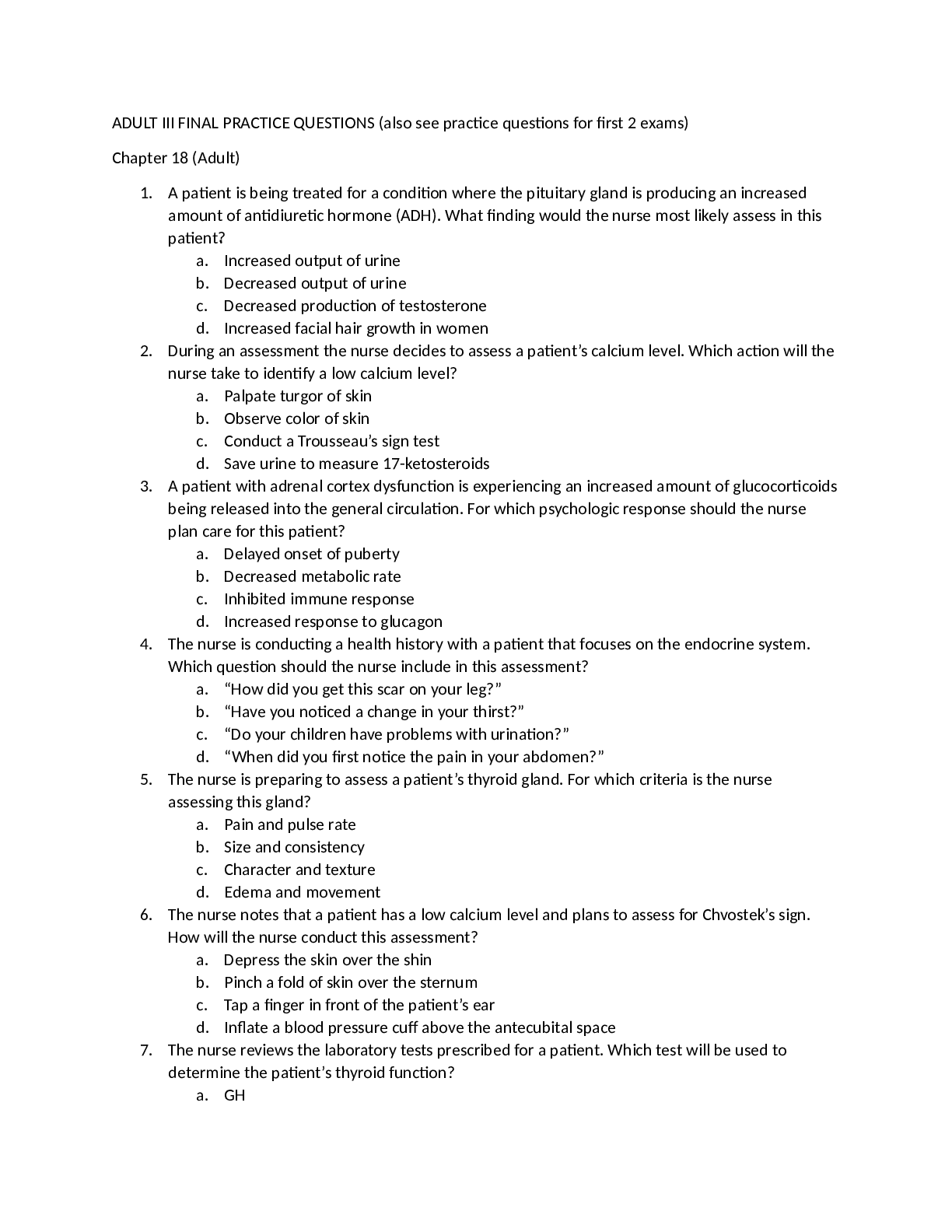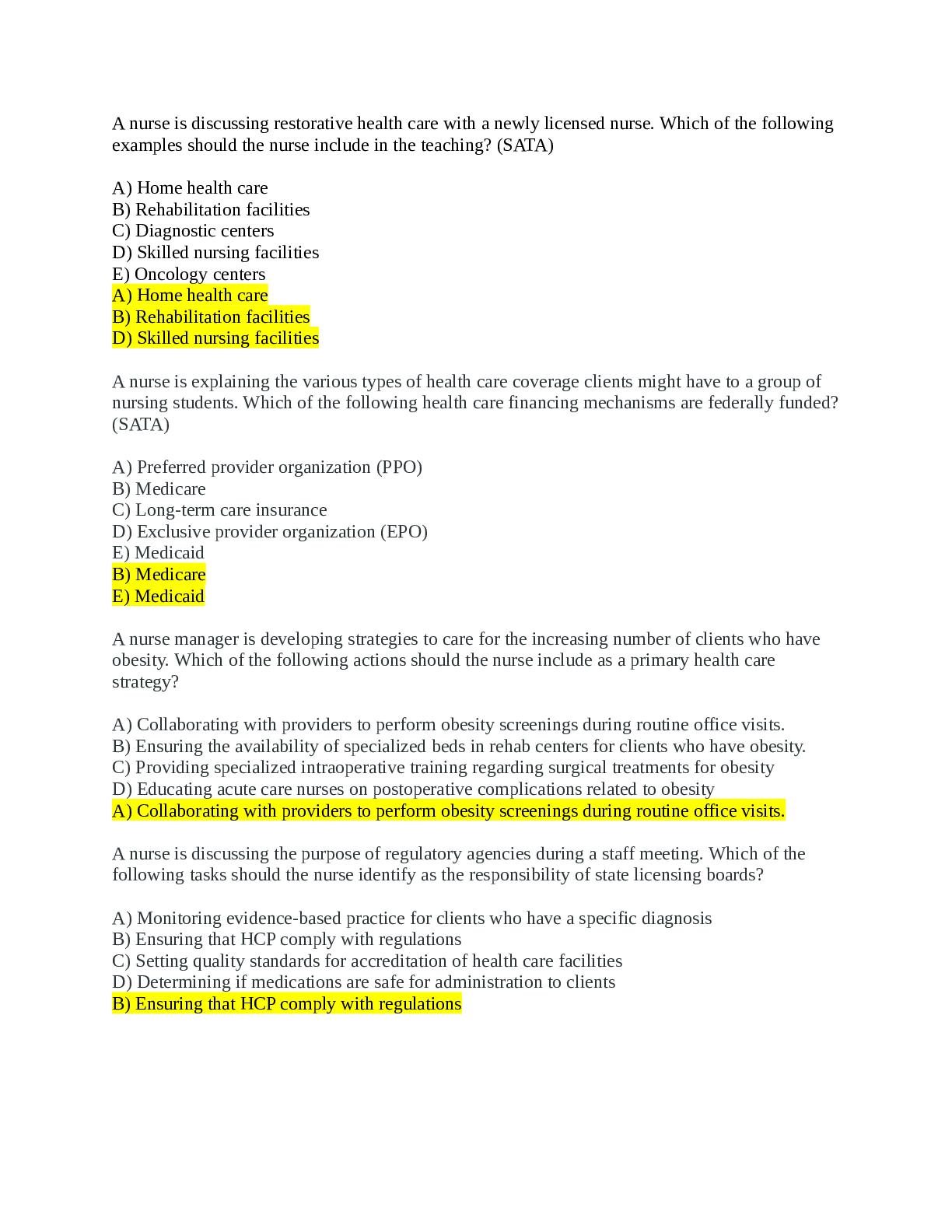Health Care > EXAM > NURS 354 ADULT III FINAL PRACTICE QUESTIONS AND ANSWERS ( 100% CORRECT) (All)
NURS 354 ADULT III FINAL PRACTICE QUESTIONS AND ANSWERS ( 100% CORRECT)
Document Content and Description Below
ADULT III FINAL PRACTICE QUESTIONS (also see practice questions for first 2 exams) Chapter 18 (Adult) 1. A patient is being treated for a condition where the pituitary gland is producing an increase... d amount of antidiuretic hormone (ADH). What finding would the nurse most likely assess in this patient? a. Increased output of urine b. Decreased output of urine c. Decreased production of testosterone d. Increased facial hair growth in women 2. During an assessment the nurse decides to assess a patient’s calcium level. Which action will the nurse take to identify a low calcium level? a. Palpate turgor of skin b. Observe color of skin c. Conduct a Trousseau’s sign test d. Save urine to measure 17-ketosteroids 3. A patient with adrenal cortex dysfunction is experiencing an increased amount of glucocorticoids being released into the general circulation. For which psychologic response should the nurse plan care for this patient? a. Delayed onset of puberty b. Decreased metabolic rate c. Inhibited immune response d. Increased response to glucagon 4. The nurse is conducting a health history with a patient that focuses on the endocrine system. Which question should the nurse include in this assessment? a. “How did you get this scar on your leg?” b. “Have you noticed a change in your thirst?” c. “Do your children have problems with urination?” d. “When did you first notice the pain in your abdomen?” 5. The nurse is preparing to assess a patient’s thyroid gland. For which criteria is the nurse assessing this gland? a. Pain and pulse rate b. Size and consistency c. Character and texture d. Edema and movement 6. The nurse notes that a patient has a low calcium level and plans to assess for Chvostek’s sign. How will the nurse conduct this assessment? a. Depress the skin over the shin b. Pinch a fold of skin over the sternum c. Tap a finger in front of the patient’s ear d. Inflate a blood pressure cuff above the antecubital space 7. The nurse reviews the laboratory tests prescribed for a patient. Which test will be used to determine the patient’s thyroid function? a. GH . b. TSH c. FBS d. Aldosterone 8. The nurse is assessing the endocrine system of an older female patient. Which finding is considered an expected age-related change in this system? a. Normal heart tones b. Decreased facial hair c. Thyroid nodules present d. Pituitary enlarged and firm 9. The nurse is caring for a patient with newly diagnosed hypothyroidism. What should the nurse expect when assessing this patient’s skin? a. Rough, dry skin b. Smooth, flushed skin c. Increased hair growth d. Cold and clammy skin 10. The nurse is assessing a patient’s deep tendon reflexes. For which endocrine disorder is this nurse assessing? a. Tetany b. Acromegaly c. Hyperthyroidism d. Cushing’s syndrome Chapter 24 (Adult) 1. A patient has been experiencing diarrhea for the past week. What should the nurse do first when caring for this patient? a. Ask the patient to describe the number and character of daily stools b. Advice the patient to abstain from all oral intake until the diarrhea subsides c. Recommend an over-the-counter antidiarrheal preparation such as Pepto-Bismol d. Question the patient about possible exposure to an enterotoxin or protozoal infection 2. A patient comes into the emergency department with manifestations of appendicitis. What is the highest priority when caring for this patient? a. Withhold all food and fluids b. Perform preoperative skin preparation c. Insert saline lock for intravenous pain medication d. Teach postoperative deep breathing, coughing, and leg exercises 3. A patient with inflammatory bowel disease is prescribed sulfasalazine (Azulfidine). What should the nurse teach the patient about taking this medication? a. Take vitamin C while on this drug b. Take the drug on an empty stomach c. Use a sunscreen while taking the drug d. Limit fluid intake to 1500 mL per day or less 4. A patient is experiencing frequent large, fatty, foul-smelling stools. What additional information should the nurse obtain from the patient? a. Known family history of colorectal cancer b. The relationship of episodes to particular foods c. History of alternating diarrhea and constipation d. Possible exposure to enterotoxins in food or water 5. A patient has heard of several friends being diagnosed with colon cancer and does not want to develop the same health problem. What should the nurse recommend to this patient? Select all that apply. a. Obtain regular exercise b. Maintain a healthy weight c. Ingest two servings of red wine every day d. Obtain recommended screening after age 50 e. Consume a diet high in fruit and vegetables and low in saturated fat and red meat 6. The nurse identifies the diagnosis Deficient Fluid Volume as appropriate for a patient with a nasogastric tube for gastric decompression. Which actions should the nurse perform to support this diagnosis? Select all that apply. a. Measure abdominal girth every 4 to 8 hours b. Provide the patient with generous amounts of oral fluids c. Keep an accurate record of intake and output every 2 to 4 hours d. Document the amount and color of nasogastric tube drainage every shift e. Listen to bowel sounds prior to checking the placement of the nasogastric tube 7. A patient has developed a paralytic ileus following a recent abdominal surgery. What is the most important nursing action when caring for this patient? a. Monitor bowel sounds every hour b. Maintain the patient on strict bed rest c. Ensure nasogastric tube is functioning d. Ensure that the patient is given a clear liquid diet 8. The nurse is preparing discharge diet teaching for a patient with diverticulosis. Which foods should the nurse teach the patient to refrain from eating? a. Soup b. Apples c. Raspberries d. Whole-wheat bread 9. An older patient is experiencing constipation. What should the nurse teach this patient to help with this health problem? Select all that apply. a. Eat a bran cereal for breakfast b. Take bisacodyl (Dulcolax) daily c. Eat plenty of fresh fruits and vegetables daily d. Eat whole-wheat bread instead of nonalcoholic fluid daily e. Drink six to eight glasses on nonalcoholic fluid daily 10. The nurse is caring for a patient with a small-bowel obstruction. Which action is the highest priority for this patient? a. Maintain nasogastric suction b. Administer prescribed analgesics c. Keep strict intake and output records d. Place the patient in semi-Fowler’s position Chapter 26 (Adult) 1. The nurse suspects that an older female patient has a health problem affecting the renal system. Which statement did the patient make that caused the nurse to come to this conclusion? a. “I leak urine all the time.” b. “I sometimes have to get up at night to urinate.” c. “When I have to urinate, I really feel an urge to go.” d. “My doctor told me I have a slight amount of protein in my urine.” 2. A patient has been vomiting for 4 hours. Which hormone will increase secretion in response to the physiologic changes caused by the vomiting? a. ADH b. Renin c. Thyroxin d. Aldosterone 3. A patient is experiencing changes in the renal system. What diagnostic test should the nurse expect to be prescribed to determine this patient’s glomerular filtration rate and glomerular damage? a. Renal scan b. Renal biopsy c. Routine urinalysis d. Creatinine clearance 4. During the health history of an older male patient, the nurse focuses on the gland that encircles the male urethra at the base of the bladder. On which organ is the nurse focusing? a. Spleen b. Prostate c. Adrenal d. Pancreas 5. During a health history interview, a patient reports having to get up to void several times during the night and there is burning when passing urine. Which terms should the nurse use when documenting this patient’s manifestations? Select all that apply. [Show More]
Last updated: 2 years ago
Preview 1 out of 41 pages

Buy this document to get the full access instantly
Instant Download Access after purchase
Buy NowInstant download
We Accept:

Reviews( 0 )
$11.00
Can't find what you want? Try our AI powered Search
Document information
Connected school, study & course
About the document
Uploaded On
Sep 14, 2022
Number of pages
41
Written in
Additional information
This document has been written for:
Uploaded
Sep 14, 2022
Downloads
0
Views
57


















.png)


 tintin.png)

.png)

